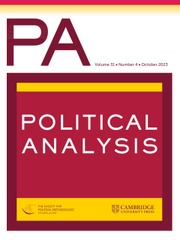Crossref Citations
This article has been cited by the following publications. This list is generated based on data provided by
Crossref.
Aronow, Peter M.
Gerber, Alan
Green, Donald P.
and
Kern, Holger L.
2013.
Double Sampling for Missing Outcome Data in Randomized Experiments.
SSRN Electronic Journal,
Schifeling, Tracy A.
Cheng, Christine
Reiter, Jerome P.
and
Hillygus, D. Sunshine
2015.
Accounting for Nonignorable Unit Nonresponse and Attrition in Panel Studies with Refreshment Samples.
Journal of Survey Statistics and Methodology,
Vol. 3,
Issue. 3,
p.
265.
Schifeling, Tracy A.
and
Reiter, Jerome P.
2016.
Incorporating Marginal Prior Information in Latent Class Models.
Bayesian Analysis,
Vol. 11,
Issue. 2,
Si, Yajuan
Reiter, Jerome P.
and
Hillygus, D. Sunshine
2016.
Bayesian latent pattern mixture models for handling attrition in panel studies with refreshment samples.
The Annals of Applied Statistics,
Vol. 10,
Issue. 1,
Chen, Heng
Felt, Marie-Hélène
and
Huynh, Kim P.
2017.
Retail Payment Innovations and Cash usage: Accounting for Attrition by using Refreshment Samples.
Journal of the Royal Statistical Society Series A: Statistics in Society,
Vol. 180,
Issue. 2,
p.
503.
Liberman, Peter
and
Skitka, Linda J.
2017.
Revenge in US Public Support for War against Iraq.
Public Opinion Quarterly,
Vol. 81,
Issue. 3,
p.
636.
Coppock, Alexander
Gerber, Alan S.
Green, Donald P.
and
Kern, Holger L.
2017.
Combining Double Sampling and Bounds to Address Nonignorable Missing Outcomes in Randomized Experiments.
Political Analysis,
Vol. 25,
Issue. 2,
p.
188.
Akande, Olanrewaju
Li, Fan
and
Reiter, Jerome
2017.
An Empirical Comparison of Multiple Imputation Methods for Categorical Data.
The American Statistician,
Vol. 71,
Issue. 2,
p.
162.
Sadinle, Mauricio
and
Reiter, Jerome P
2019.
Sequentially additive nonignorable missing data modelling using auxiliary marginal information.
Biometrika,
Vol. 106,
Issue. 4,
p.
889.
Schifeling, Tracy
Reiter, Jerome P
and
Deyoreo, Maria
2019.
Data Fusion for Correcting Measurement Errors.
Journal of Survey Statistics and Methodology,
Vol. 7,
Issue. 2,
p.
175.
Taylor, Laura K.
Tong, Xin
and
Maxwell, Scott E.
2020.
Evaluating Supplemental Samples in Longitudinal Research: Replacement and Refreshment Approaches.
Multivariate Behavioral Research,
Vol. 55,
Issue. 2,
p.
277.
Tong, Xin
and
Zhang, Zhiyong
2020.
Robust Bayesian Approaches in Growth Curve Modeling: Using Student’s t Distributions versus a Semiparametric Method.
Structural Equation Modeling: A Multidisciplinary Journal,
Vol. 27,
Issue. 4,
p.
544.
Tong, Xin
and
Ke, Zijun
2021.
Assessing the Impact of Precision Parameter Prior in Bayesian Non-parametric Growth Curve Modeling.
Frontiers in Psychology,
Vol. 12,
Issue. ,
Akande, Olanrewaju
and
Reiter, Jerome P.
2022.
Statistics in the Public Interest.
p.
289.
Si, Yajuan
West, Brady T.
Veliz, Philip
Patrick, Megan E.
Schulenberg, John E.
Kloska, Deborah D.
Terry‐McElrath, Yvonne M.
and
McCabe, Sean E.
2022.
An empirical evaluation of alternative approaches to adjusting for attrition when analyzing longitudinal survey data on young adults' substance use trajectories.
International Journal of Methods in Psychiatric Research,
Vol. 31,
Issue. 3,
Muszyńska-Spielauer, Magdalena M
and
Spielauer, Martin
2023.
The effect of sample attrition in the EU Statistics on Income and Living Conditions on the estimates of Eurostat’s Healthy Life Years.
European Journal of Public Health,
Vol. 33,
Issue. 3,
p.
378.
Sengupta, Nandana
Udell, Madeleine
Srebro, Nathan
and
Evans, James
2023.
Sparse Data Reconstruction, Missing Value and Multiple Imputation through Matrix Factorization.
Sociological Methodology,
Vol. 53,
Issue. 1,
p.
72.
Si, Yajuan
Little, Roderick J. A.
Mo, Ya
and
Sedransk, Nell
2023.
A Case Study of Nonresponse Bias Analysis in Educational Assessment Surveys.
Journal of Educational and Behavioral Statistics,
Vol. 48,
Issue. 3,
p.
271.
Si, Yajuan
Little, Roderick J.A.
Mo, Ya
and
Sedransk, Nell
2024.
Nonresponse Bias Analysis in Longitudinal Studies: A Comparative Review with an Application to the Early Childhood Longitudinal Study.
International Statistical Review,




